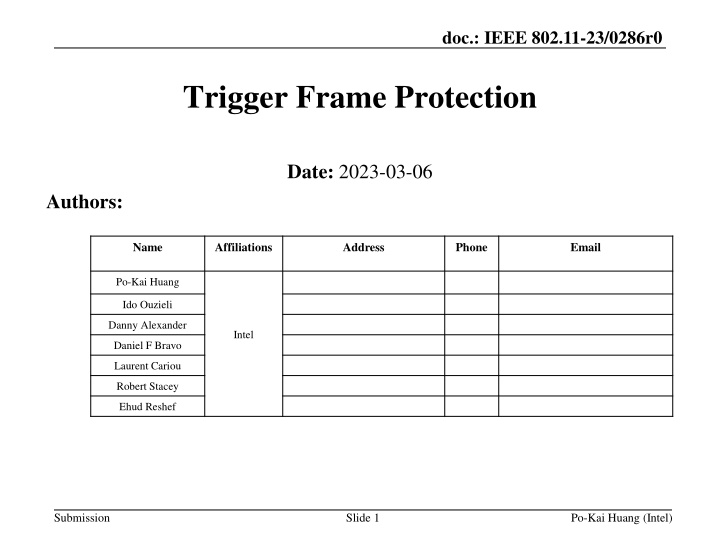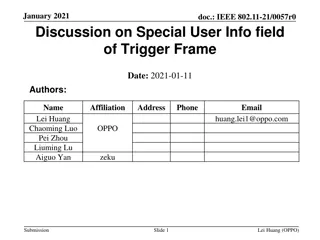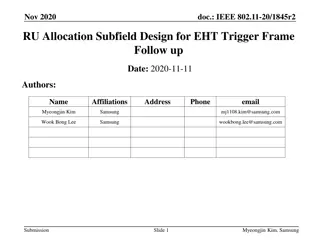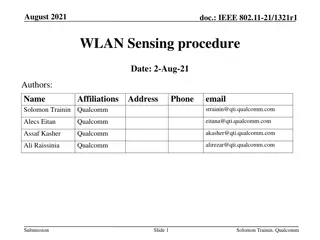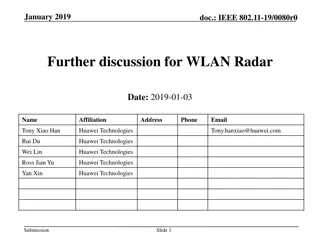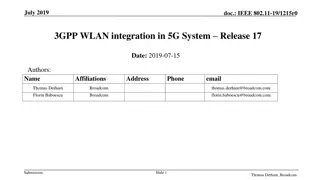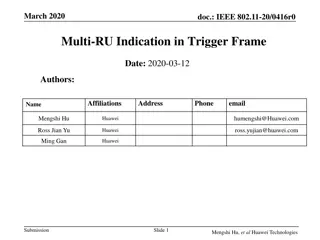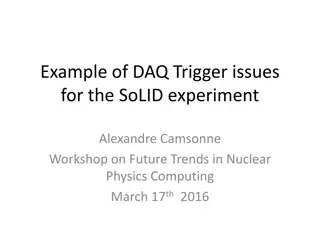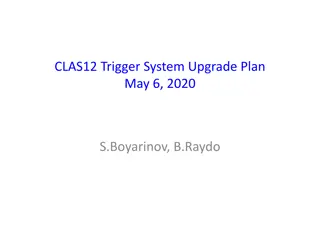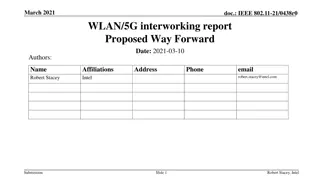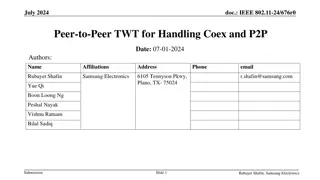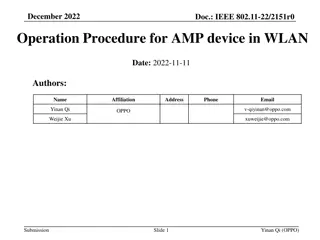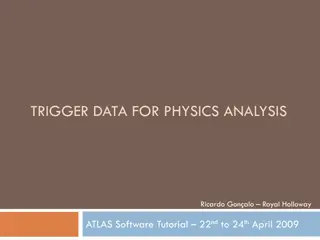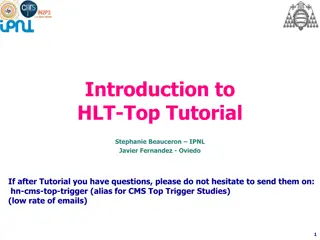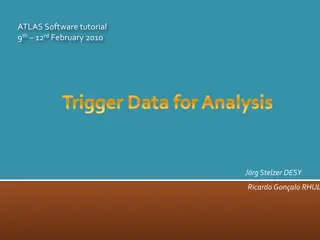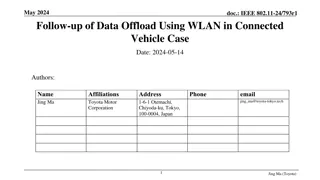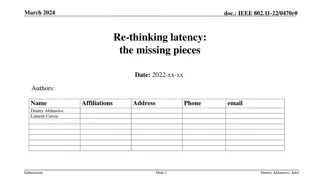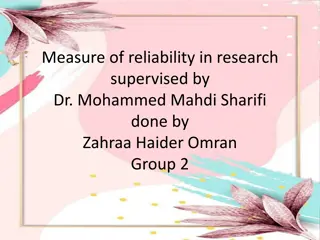Enhancing WLAN Reliability with Trigger Frame Protection
This document discusses the usage of Trigger frame for improving WLAN connectivity reliability and reducing power consumption. It highlights the importance of Trigger frame protection to prevent various attack scenarios on clients.
Download Presentation

Please find below an Image/Link to download the presentation.
The content on the website is provided AS IS for your information and personal use only. It may not be sold, licensed, or shared on other websites without obtaining consent from the author.If you encounter any issues during the download, it is possible that the publisher has removed the file from their server.
You are allowed to download the files provided on this website for personal or commercial use, subject to the condition that they are used lawfully. All files are the property of their respective owners.
The content on the website is provided AS IS for your information and personal use only. It may not be sold, licensed, or shared on other websites without obtaining consent from the author.
E N D
Presentation Transcript
doc.: IEEE 802.11-23/0286r0 Trigger Frame Protection Date: 2023-03-06 Authors: Name Affiliations Address Phone Email Po-Kai Huang Ido Ouzieli Danny Alexander Intel Daniel F Bravo Laurent Cariou Robert Stacey Ehud Reshef Submission Slide 1 Po-Kai Huang (Intel)
doc.: IEEE 802.11-23/0286r0 Abstract Goal of UHR: The Study Group will investigate technology which may improve reliability of WLAN connectivity, reduce latencies, increase manageability, increase throughput including at different SNR levels, and reduce device level power consumption. We discuss the consideration of reliability for wireless connectivity and power consumption using Trigger frame Submission Slide 2 Po-Kai Huang (Intel)
doc.: IEEE 802.11-23/0286r0 Usage of Trigger frame Trigger frame has been used significantly in a BSS in 802.11ax and 802.11be MU-RTS/BSRP frame for initiation of various power save operation like SMPS and eMLSR MU-BAR/GCR MU-BAR to solicit block ack Basic Trigger frame/BFRP/BSRP/BQRP to solicit data and reports Client continues to send useless data, which wastes power and medium Client may have to shift window without PBAC or lose capability to move window quickly with PBAC by using ADDBA with PBAC Client has to wake up for nothing and lose power. Similar to the attack of wakeup packet in 11ba Submission Slide 3 Po-Kai Huang (Intel)
doc.: IEEE 802.11-23/0286r0 Usage of Trigger frame Trigger frame has been used significantly in a BSS in 802.11ax and 802.11be without protection Attacker sends MU-RTS/BSRP frame for useless initiation of various power save operation like SMPS and eMLSR Client has to wake up for nothing and lose power. Similar to the attack of WUR frame in 11ba Attacker sends MU-BAR/GCR MU-BAR to solicit block ack Client may have to shift window without PBAC or lose capability to move window quickly by using separate management frame with PBAC Attacker sends Basic Trigger frame/BFRP/BSRP/BQRP to solicit data and reports Client sends useless data/padding, which wastes power and medium Submission Slide 4 Po-Kai Huang (Intel)
doc.: IEEE 802.11-23/0286r0 Proposal: Trigger frame protection With Trigger frame protection, all the attack scenarios for client can be prevented directly Client does not respond to fake MU-RTS/BSRP and wake up to lose power Client can still move window and respond BA based on MU-BAR Client does not respond to fake Trigger variant with long duration Trigger frame protection can be achieved with similar method of Beacon frame protection Use BIP Use cipher suite indicated in group management cipher suite Have a key ID field, PN field, MIC field signaling inside the protected Tigger frame Submission Slide 5 Po-Kai Huang (Intel)
doc.: IEEE 802.11-23/0286r0 Further high level consideration One key/PN under Multiple BSSID with one Trigger frame similar to the design of BIGTK Key/PN may be the same as BIGTK/BIPN but due to lower layer processing Trigger frame, which is a control frame, separate replay counter is needed if we go this route Different key for each link of MLD similar to BIGTK and delivered with similar approach of BIGTK if different AAD construction includes FC/RA/TA with appropriate mask similar to Beacon protection Fields before FCS can be part of the MIC computation Rekey can use group key handshake like BIGTK Submission Slide 6 Po-Kai Huang (Intel)
doc.: IEEE 802.11-23/0286r0 Conclusion We discuss the consideration of reliability for wireless connectivity using Trigger frame in a BSS We propose to have Trigger frame protection to prevent attack that drain power and resolve issues addressed by PBAC in a better way Various design consideration under Beacon protection can be reused in Trigger frame protection Submission Slide 7 Po-Kai Huang (Intel)
doc.: IEEE 802.11-23/0286r0 Straw Poll #1 Do you support to consider Trigger frame protection in UHR? Submission Slide 8 Po-Kai Huang (Intel)
